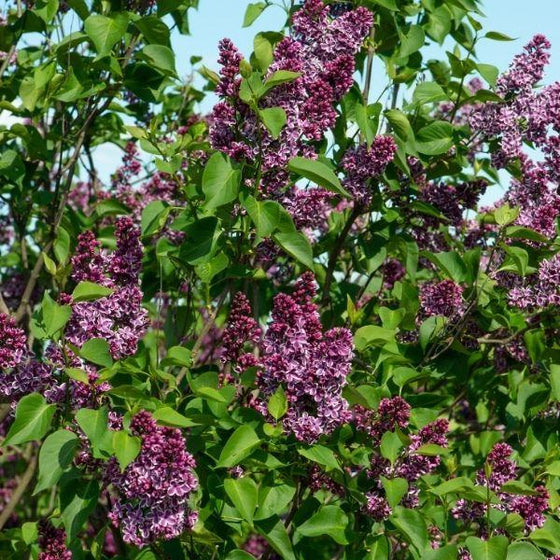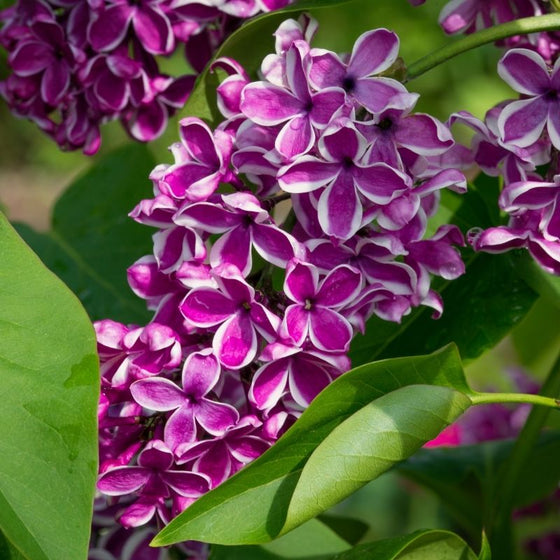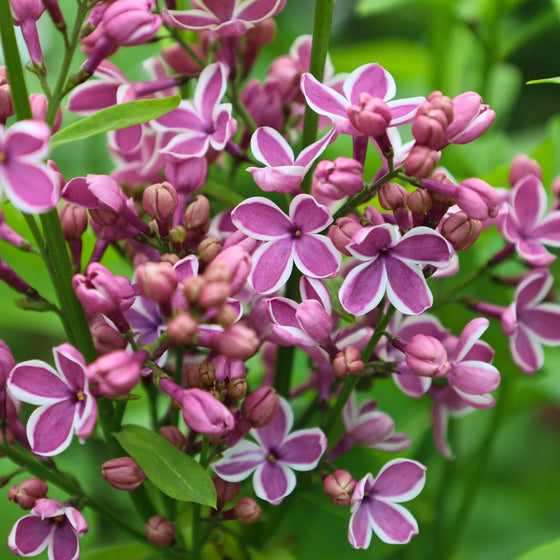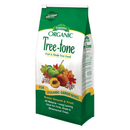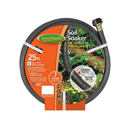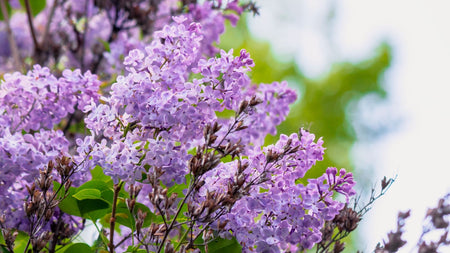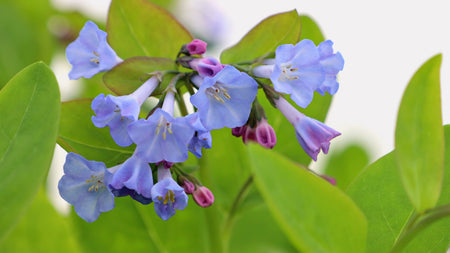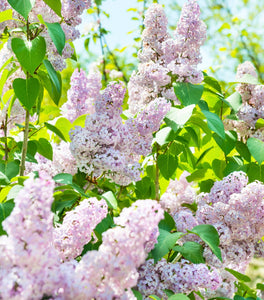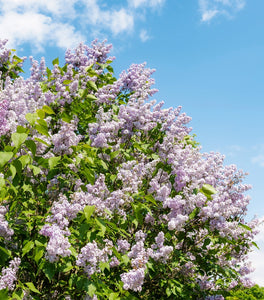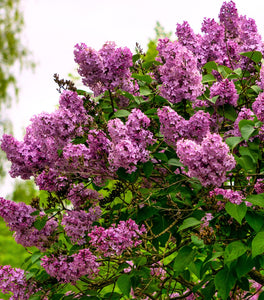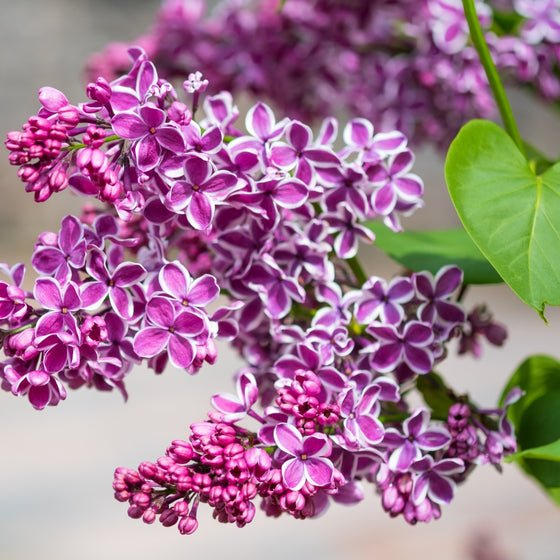
Images Depict Mature Plants
Sensation Lilac Shrubs
Lilac ‘Sensation’ (Syringa vulgaris 'Sensation') is a stunning and unique flowering shrub known for its eye-catching bi-colored blooms and sweet fragrance. This old-fashioned lilac variety produces large, conical clusters of deep purple flowers edged in bright white, creating a two-toned "sensation" that lives up to its name. Blooming in mid to late spring, Lilac Sensation adds a burst of color and perfume to the landscape, making it a favorite among gardeners and pollinators alike. With its upright, multi-stemmed form and lush green foliage, this lilac also offers attractive structure and privacy throughout the growing season.
Ideal for planting in full sun and well-drained soil, Lilac Sensation reaches a mature height of 8 to 10 feet and spreads 6 to 8 feet wide, making it a bold and beautiful specimen shrub, flowering hedge, or anchor plant in mixed borders. It thrives in USDA Zones 3–7 and performs best in areas with cold winters that allow it to go fully dormant. Once established, this low-maintenance lilac is highly deer-resistant, drought-tolerant, and responds well to pruning right after flowering to maintain its shape and encourage strong future blooms.
Whether planted as a focal point or used in a fragrant cottage-style garden, Sensation Lilac provides long-lasting spring interest and old-world charm. Its aromatic flowers make excellent cut stems for floral arrangements, and its vibrant color and scent invite butterflies, bees, and hummingbirds into your yard. With its combination of beauty, resilience, and pollinator appeal, Lilac Sensation is a must-have addition to any traditional or modern garden design.
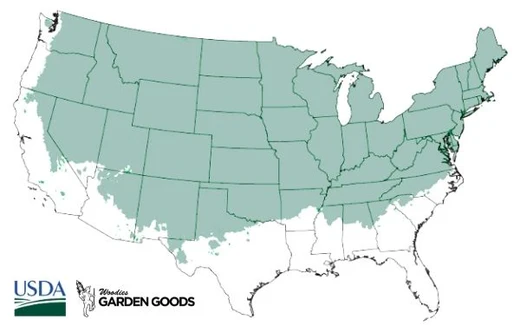
| Hardiness Zone | 3-7 |
|---|---|
| Mature Height: | 8 to 10 feet |
| Mature Width: | 5 to 6 Feet |
| Classification: | Broad leaved deciduous shrub, re-blooming |
| Sunlight: | Full sun |
| Habit: | Upright, rounded habit |
| Foliage: | Dark green |
| Flower Color: | Purple red edged in white |
| Pruning Season: | No pruning needed |
| Soil Condition: | Any well-drained soil |
| Water Requirements: | Water well until established |
| Uses: | Tolerates moist soil and full sun. Full sun brings out the best flowering. Will adapt to drier sites |
How to Care for Lilac Sensation
Be sure to read our planting instructions to ensure healthy and happy Sensation Lilac Shrubs for years to come!
How do I plant my Lilac Sensation Shrub?
To plant your Lilac Sensation shrub, start by selecting a location that receives full sun—at least six hours of direct sunlight daily—for optimal flowering and healthy growth. This lilac thrives in well-drained, slightly alkaline soil, so consider amending heavy clay or acidic soil with compost and garden lime if needed. Dig a hole twice as wide and just as deep as the root ball, and loosen the surrounding soil to encourage root expansion. Gently remove the shrub from its container, place it in the hole at the same level it was growing in the pot, and backfill with native soil mixed with compost. Water thoroughly to eliminate air pockets and help the roots settle in. After planting your Sensation Lilac, apply a 2- to 3-inch layer of mulch around the base, keeping it a few inches away from the main stem to prevent rot. Mulching helps retain moisture, regulate soil temperature, and reduce weed competition. If you're planting multiple lilacs for a hedge or screen, space them about 6 to 8 feet apart to allow for full growth and good air circulation, which helps prevent disease. Avoid fertilizing heavily at planting time—an organic starter fertilizer or bone meal can be added if desired, but too much nitrogen may reduce blooming. With proper site preparation and care, your Sensation Lilac shrub will reward you with fragrant, show-stopping blooms each spring.
How do I water Lilac Sensation?
Watering your Lilac Sensation shrub properly is key to establishing strong roots and promoting healthy, vibrant blooms. During the first growing season after planting, water deeply once or twice a week, depending on weather conditions and soil type. Aim to keep the soil consistently moist but never soggy—overwatering can lead to root rot, especially in poorly drained areas. Use a soaker hose or slow trickle from a garden hose at the base of the plant to ensure the water penetrates deeply into the root zone. Early morning is the best time to water, helping to reduce evaporation and minimize the risk of fungal disease. Once your Sensation Lilac is well established—typically after the first year—it becomes relatively drought-tolerant and only needs supplemental watering during extended dry periods. Monitor the soil during hot summer months and water when the top 2–3 inches become dry. Applying a layer of mulch around the base of the shrub helps retain moisture, regulate soil temperature, and reduce weed competition. Avoid frequent shallow watering, which can lead to weak, shallow roots. With a thoughtful watering routine, your Lilac Sensation shrub will thrive and deliver a spectacular spring display of fragrant, two-toned blooms year after year.
How do I fertilize My Lilac Sensation?
To fertilize your Lilac Sensation shrub effectively, apply a balanced, slow-release fertilizer in early spring just as new growth begins. A formula such as 10-10-10 or 5-10-5 works well to support both healthy foliage and abundant blooms. Scatter the fertilizer evenly around the base of the shrub, keeping it a few inches away from the main stem, and water it in thoroughly to help nutrients reach the root zone. For an organic approach, compost or well-aged manure can also be incorporated into the soil around the shrub to provide a steady source of nutrients. Avoid high-nitrogen fertilizers, as they can promote lush leafy growth at the expense of flower production. Lilac Sensation performs best in moderately fertile, well-drained soil with a slightly alkaline pH, so adding a small amount of garden lime may also enhance performance if your soil is overly acidic. After flowering, you can give the shrub a light boost with a low-nitrogen fertilizer to support root strength and next year’s bloom development. With proper fertilization and care, your Sensation Lilac shrub will reward you with vibrant, fragrant blossoms and strong, healthy growth season after season.

How and When Should I Prune My Lilac Sensation Shrubs?
Pruning your Lilac Sensation shrubs at the right time is essential to maintain their shape, promote air circulation, and ensure abundant blooming year after year. The best time to prune is immediately after flowering in late spring or early summer, as Sensation Lilacs bloom on old wood—meaning flower buds form on stems produced the previous year. Remove spent flower clusters to encourage energy to go toward new growth rather than seed production. At the same time, thin out about a third of the oldest stems near the base to promote rejuvenation and allow sunlight to penetrate the interior of the shrub. Annual maintenance pruning helps keep your Sensation Lilac shrub vigorous and blooming profusely. Avoid heavy pruning in fall or early spring, as this can remove next season’s flower buds and reduce blooming. Over time, if the shrub becomes overgrown or woody, you can perform a more drastic rejuvenation pruning by cutting back one-third of the oldest stems to ground level over the course of three years. With consistent pruning right after bloom time, Lilac Sensation will maintain a tidy shape, resist disease, and continue to produce its signature bi-colored, fragrant flowers each spring.

